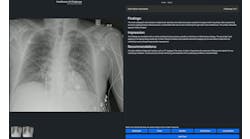Screening for diabetic retinopathy remains a challenge for patient care organizations nationwide, particularly those that are small or rural. One hospital organization, Mary Lanning Healthcare, in Hastings, Nebraska, faced a bundle of challenges in that area.
Per that, recent statistics find that nearly 30 percent of the 37 million Americans with diabetes, suffer from diabetic retinopathy. What’s more, about 50 percent of U.S. patients do not receive the recommended annual eye exams needed to detect the presence of diabetic retinopathy. Fortunately, the Food and Drug Administration (FDA) has cleared the use of autonomous artificial intelligence (AI) for point-of-care diabetic retinopathy detection.
Per all that, Steven Yeh, M.D., a practicing ophthalmologist at the University of Nebraska Medical Center (Omaha) and a professor at the University of Nebraska; and Jessica Sutton, R.N., manager of primary care at Mary Lanning Healthcare, presented about the initiative on March 14 at the HIMSS Conference in Orlando; sometime later, they both spoke with Healthcare Innovation Editor-in-Chief Mark Hagland regarding the experience of leading that initiative. Below are excerpts from the two interviews.
Dr. Yeh, tell me about your own clinical practice?
Yes, I’m an ophthalmologist specializing in retina issues and uveitis, and I’ve been in practice for over 13 years.
And how did the Mary Lanning initiative originate?
Diabetic retinopathy, as we know, is a highly significant public health problem, and is the leading cause of vision loss in diabetics. Thirty-seven million Americans have diabetes, and 30 percent of those are at risk for vision loss. Patients have lost vision because of delay in detection. American Academy of Ophthalmology recommend an annual screening.
We became interested in the possibility of leveraging AI for point-of-care detection of diabetic retinopathy. The first FDA-approved screening tool has been approved for the detection of vision-threatening retinopathy; it’s produced by a company called Eyenuk (based in Woodland Hills, Calif.). It really affords patients the immediate ability to understand whether they might need additional evaluation after the first test, if diabetic retinopathy has been detected. What’s important here is that, using this technology, DR can now be detected in the primary care office. And our colleagues at Mary Lenning Hospital in Hastings have deployed it in their primary care clinics. The solution is called EyeArt.
So PCPs are using EyeArt in their clinics, then, correct?
Yes, someone will take an undilated image of the retina, and the image is uploaded to a cloud-based server, and the ocular fundus, the retina, can be returned to function within a half-hour.
So that means there’s an AI-based preliminary diagnosis?
Yes, it’s a highly sensitive test. And there’s an over 95-percent sensitivity for detecting diabetic retinopathy.
So that preliminary diagnosis will lead to an immediate referral to an ophthalmologist?
Yes. That’s the advantage of having specialties working together. And the use of the camera taking a high-quality picture. Patients don’t need eye drops and dilation to have this done.
Can you talk about the detection rate?
Yes, and that discussion involves both sensitivity and specificity metrics. Sensitivity: if the test turns out positive, when is DR truly there? It’s over 95-percent sensitive for detection of a positive result. There’s vision-threatening diabetic retinopathy: severe, advanced disease: retinal swelling (macular edema), or proliferative disease, with abnormal blood vessels; or more-than-mild retinopathy. Vision-threatening requires an urgent referral, within a month. More-than-mild: small hemorrhages, vascular changes, etc.
So when it comes to vision-threatening diabetic retinopathy, a patient would already have had symptoms?
Not necessarily; while 25-30 percent of patients will experience retinal changes of some sort, other patients are asymptomatic.
So this kind of technology is making a difference, then?
I’m really enthusiastic about the deployment of this technology; it offers additional technology available to patients. If patients are able to be detected in a PCP’s office, that can generate a referral and activate that access point. And that can address health disparities, such as around transportation. Often as ophthalmologists, we can be siloed, but working in a setting where we’re communicating back and forth with primary care physicians, that’s really an important way to address some of those nuances. And when our primary care colleagues have questions about findings, they can access consults with us. And the electronic health record involved is Epic, and EyeArt is linked to it.
Where is AI headed in ophthalmology going forward?
I think it’s a really exciting time for AI. The eye is a window to your systemic health. And we should keep in mind that AI could help us in a number of areas, such as macular degeneration and glaucoma; people are doing research around uveitis as well. AI will give us additional information about disease states, and will help with macular degeneration and other important public health issues. And as we learn to implement these technologies responsibly, it can help us to look at resources, and help us to address some health disparities globally. It’s a really exciting time; In fact, moving forward, the plan is to expand the footprint of EyeArt to additional clinics in Nebraska Medicine. It’s two clinics at UNMC. We have two in Omaha (one is Bellevue). And Mary Lanning is in Hastings.
Jessica, tell us about your hospital’s involvement in the initiative?
We are a Community Connect site in Epic, so we were included in a diabetes grant, a two-year grant project on diabetes. That’s how were introduced to Eynuk. We are an independent, 170-bed hospital, with one primary care office, several specialty clinics.
And when was this technology rolled out?
In February 2023.
How many procedures have been done?
273 gradable procedures [as of this spring]
How many have turned up potential retinopathy?
In terms of more-than-mild, 49; and vision-threatening, 22.
So a positive diagnosis will prompt a specialist referral?
Yes, absolutely. The actionable report it produces, triages the way that the patient is managed. If they’re more-than-mild, they’ll be referred to a specialist; if it’s vision-threatening, they’re referred to a retina center. Yes, it’s a higher percentage of patients who go for the appointment; we actually call and make the appointment for them. We have a process where we follow up on that.
And you’re increasing the potential for follow-up care?
Yes, and for the patient, scheduling appointments on their own is daunting. So if we can ease that burden for them, that is also a win.
Were there any challenges in executing on this initiative?
Just bringing this to primary care and making sure we had open communication with the vision care providers in town. We needed to make sure they understood we weren’t trying to steal patients, we were actually trying to increase referrals to them. We can free up their schedules for patients who had actionable findings.
What about the physicians in your own clinic?
We had complete buy-in from them from day one. If it weren’t so user-friendly and easy to operate and put providers behind in their schedules, that might have been different. But it doesn’t interrupt their workflow.
What has the response from patients been?
Totally positive. It takes less than five minutes; we just tell patients it’s part of their visit. And the patients, obviously the 75 who had findings, were super-grateful, to have that referral source.
What should anyone know about implementing this and making it a smooth process?
As with any new process or equipment, there were just some workflow elements to work through. But it really was a smooth process. I had great buy-in from my providers, and great feedback from patients. Everything was really smooth. And from our perspective, in explaining it to eye-care providers, we said, we wouldn’t send a patient with a cough to a pulmonologist.
Is there anything you’d like to add?
There’s an element here around quality measures and reimbursement. Quality-metric-wise, before we started the process, 54 percent of patients were screened for diabetic retinopathy, and now we’re at 76 percent. And we’re already reaching a return on investment. We’ve seen reimbursement come back fully.


